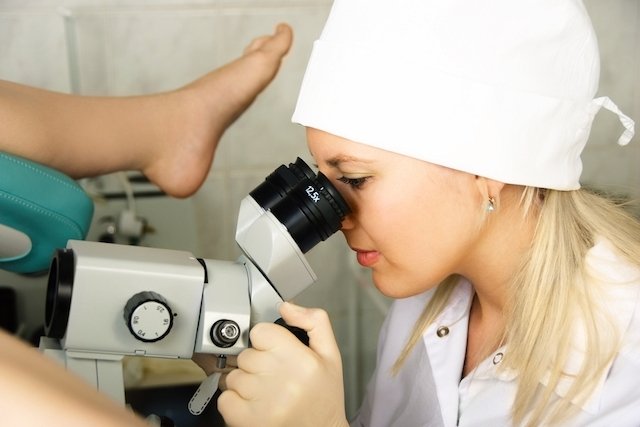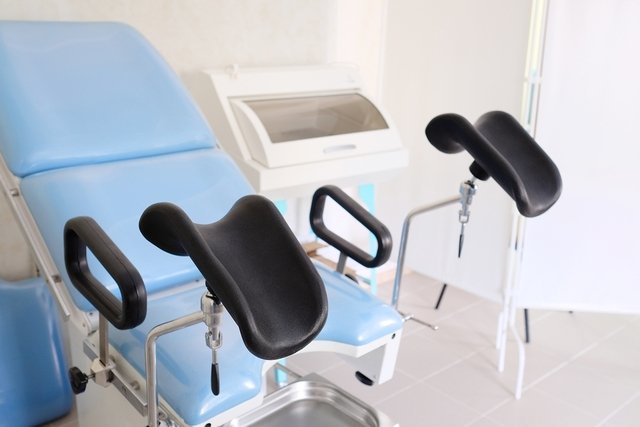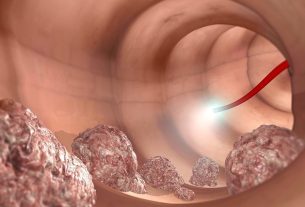Colposcopy is a gynecological examination in which the vulva, vagina and cervix are observed in very detail, looking for signs that may indicate inflammation or diseases such as HPV and cancer.
Generally, the gynecologist performs this examination when, during the gynecological examination, lesions are visualized on the cervix or vagina or when the Pap smear test showed any changes.
This exam is simple and doesn’t hurt, but it can cause minor discomfort and a burning sensation when the gynecologist applies products that help to better observe the cervix and vagina. During the examination, if the doctor notices the presence of any suspicious changes, he or she can collect a sample for a biopsy to be performed.

What is it for
Colposcopy serves to:
- Investigate inflammation in the cervix, called cervicitis;
- Identify benign polyps;
- Identify lesions indicative of cervical cancer;
- Investigate the cause of excessive and/or nonspecific vaginal bleeding;
- Check for the presence of precancerous lesions in the vagina and vulva;
- Investigate the cause of pelvic pain;
- Analyze genital warts or other lesions that can be identified visually.
Colposcopy is normally indicated after an abnormal Pap smear result, however it can also be requested as a routine gynecological exam and can be performed together with the Pap smear. Understand what the Pap smear test is and how it is done.
Preparation for colposcopy
To perform colposcopy, certain precautions must be taken, such as:
- Inform your doctor about the use of anticoagulant medicationssuch as warfarin, heparin, rivaroxaban or acetylsalicylic acid, as they may increase the risk of bleeding if a biopsy is performed;
- Not having sexual intercourse for 48 hours before the exam, even if using a condom;
- Do not use tamponsvaginal douche, creams or other vaginal medications, for 24 hours before the exam;
- Not menstruatingunless the examination was requested to investigate the cause of excessive and/or non-specific vaginal bleeding;
- Empty the bladderimmediately before the exam,
- Tell your doctor if you are allergic to iodineas Schiller’s solution and Lugol’s solution have iodine in their composition;
- Tell your doctor if you are allergic to other medications or latex, for example;
- Take your usual medicines normallyas per medical advice.
Furthermore, in order to avoid pain or discomfort during colposcopy, the doctor may recommend that the woman take an analgesic, such as ibuprofen, approximately 30 to 60 minutes before the exam.
It is also recommended that women bring the results of their last Pap smear or another test they have had recently, such as a transvaginal ultrasound, abdominal ultrasound or blood tests.
How it is made
Colposcopy is a simple and quick exam in which the woman needs to be in a gynecological position for the procedure to be carried out. Then, the gynecologist will follow the following steps to perform the colposcopy:
- Inserting a small instrument called a speculum into the vaginathe same used in routine gynecological examination, to keep the vaginal canal open and allow better observation of the cervix;
- Place the colposcopewhich is a type of microscope that looks like binoculars, held in front of the woman to allow an enlarged and detailed view of the wall of the vagina, vulva and cervix;
- Apply different products to the cervix, if necessary, such as acetic acid, to eliminate mucus and allow better visualization of the cervix, or Lugol’s solution or Schiller’s solution, to identify changes in the region. It is during this moment that the woman may feel a little burning.
Furthermore, during the procedure the doctor can also use the instrument to take enlarged photographs of the cervix, vulva or vagina to include in the final exam report.
Colposcopy with biopsy
If changes are identified during the examination, the doctor can collect a small sample from the region for the biopsy to be performed, thus making it possible to know whether the change identified is benign or malignant and, in this case, treatment can be started. adequate. Understand how the biopsy is performed and how to understand the result.
Is it possible to have colposcopy during pregnancy?
Colposcopy can also be performed normally during pregnancy, as it does not cause any harm to the fetus, even if the procedure is performed using a biopsy.
If any changes are identified, the doctor will assess whether treatment can be postponed until after birth, when a new examination will be carried out to assess the progress of the problem.
How to understand the result
During colposcopy, the gynecologist must inform you if he found any changes in the cervix, vagina or vulva, and if changes were seen, perform a biopsy.
The result of the colposcopy with biopsy is interpreted by the gynecologist, who may indicate the presence of altered cells in the region where the biopsy was performed. In this case, depending on the degree of change in the cells, the doctor can recommend the most appropriate treatment. Find out how cervical cancer is treated.
Care after colposcopy
Colposcopy is a quick exam and lasts about 15 to 20 minutes, and after the exam, pain or discomfort in the vagina or vulva may occur for about 1 to 2 days, due to the use of the speculum or the application of products. in the cervix.
Furthermore, if colposcopy with biopsy was performed, cramps, light bleeding or brown discharge may occur. In this case, you should avoid having sex or using vaginal douches or tampons for 1 week after the exam, to allow the cervix to heal.
Possible complications of the exam
Colposcopy is a safe exam, generally not causing complications during the procedure. However, in some cases, especially when colposcopy with biopsy is performed, excessive vaginal bleeding, foul-smelling discharge, severe cramping, fever or chills may occur.
In these cases, it is important to contact your gynecologist immediately or go to the nearest emergency room, as it may indicate an infection.
Bibliography
- THE AMERICAN COLLEGE OF OBSTETRICIANS AND GYNECOLOGISTS. Colposcopy. 2020. Disponível em: <https://www.acog.org/patient-resources/faqs/special-procedures/colposcopy>. Acesso em 17 mar 2022
- PRENDIVILLE, W.; SANKARANARAVANAN, R. Colposcopy and Treatment of Cervical Precancer. Lyon (FR): International Agency for Research on Cancer. (IARC Technical Report, No. 45.), 2017
- PRETORIUS, RG; BELINSON, JL Colposcopy. Minerva Gynecologist. 64. 2; 173-80, 2012
- REDMAN, CWE; et al. European consensus statement on essential colposcopy. Eur J Obstet Gynecol Reprod Biol. 256. 57-62, 2021
- KHAN, M.J.; et al. ASCCP Colposcopy Standards: Role of Colposcopy, Benefits, Potential Harms, and Terminology for Colposcopic Practice. J Low Genit Tract Dis. 21. 4; 223-229, 2017
- NATIONAL CANCER INSTITUTE (BRAZIL). GENERAL COORDINATION OF STRATEGIC ACTIONS. DIVISION OF SUPPORT FOR THE ONCOLOGY CARE NETWORK – RIO DE JANEIRO: INCA. Brazilian guidelines for cervical cancer screening / National Cancer Institute. 2011. Available at: <https://bvsms.saude.gov.br/bvs/publicacoes/inca/rastreamento_cancer_colo_utero.pdf>. Accessed on March 17, 2022
- NATIONAL CANCER INSTITUTE (BRAZIL). GENERAL COORDINATION OF STRATEGIC ACTIONS. DIVISION OF SUPPORT FOR THE ONCOLOGY CARE NETWORK – RIO DE JANEIRO: INCA. Brazilian guidelines for cervical cancer screening / National Cancer Institute. 2011. Available at: <https://bvsms.saude.gov.br/bvs/publicacoes/inca/rastreamento_cancer_colo_utero.pdf>. Accessed on March 17, 2022

Sign up for our newsletter and stay up to date with exclusive news
that can transform your routine!
Warning: Undefined array key "title" in /home/storelat/public_html/wp-content/plugins/link-whisper-premium/templates/frontend/related-posts.php on line 12
Warning: Undefined array key "title_tag" in /home/storelat/public_html/wp-content/plugins/link-whisper-premium/templates/frontend/related-posts.php on line 13




